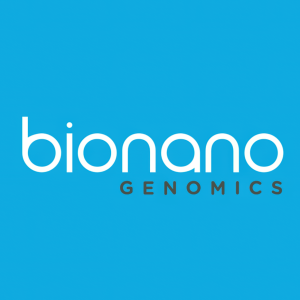Bionano Announces Publication of Largest Prospective Prenatal Study Comparing OGM to Chromosomal Microarray Analysis and Karyotyping
Key findings from prospective evaluation of 200 prenatal samples:
- Optical genome mapping (OGM) detected pathogenic structural variants (SVs) in
20.5% of samples (41/200); combination of chromosomal microarray analysis (CMA) and karyotyping (KT) detected pathogenic SVs in19.5% of samples (39/200) - Compared to CMA and KT combined in this prospective cohort, OGM had the following performance:
- Sensitivity:
97.4% - Specificity:
100% - Positive Predictive Value (PPV):
100% - Negative Predictive Value (NPV):
99.4%
- Sensitivity:
- For 8 copy number variants (CNVs) detected by CMA, OGM defined their location and orientation and revealed that they were 6 tandem duplications and 2 unbalanced cryptic translocations
- In
4% of samples (8/200), OGM identified D4Z4 repeat contractions on the permissive 4qA haplotype that may indicate facioscapulohumeral muscular dystrophy type 1 (FSHD1)
SAN DIEGO, Dec. 26, 2023 (GLOBE NEWSWIRE) -- Bionano Genomics, Inc. (Nasdaq: BNGO) today announced a publication covering the largest independent prospective prenatal study comparing optical genome mapping (OGM) to a combined workflow of chromosomal microarray analysis (CMA) and karyotyping (KT). The study highlighted OGM’s high analytical concordance with the combined workflow of CMA and KT, and its ability to detect novel pathogenic structural variants (SVs) missed by those methods. The study also highlighted OGM’s potential to provide additional information about SVs and copy number variants (CNVs) compared to CMA and KT.
The study, published by researchers from Nanjing Women and Children’s Healthcare Hospital in China, reported that OGM demonstrated robust performance across multiple technical and analytical metrics when compared to CMA and KT. OGM also revealed the location and orientation of duplication segments, refined breakpoints of SVs and identified specific repeat contraction disorders that were not detected by other methods.
Researchers used 200 unique prospective prenatal samples with soft markers (including increased nuchal translucency, nasal bone hypoplasia and mild ventriculomegaly, and structural anomalies) for the study. Within this prospective cohort, OGM showed a
“The use of OGM for the analysis of prenatal samples is an area where we believe our workflow can have tremendous global impact. We believe this study marks a milestone in the Chinese prenatal research market as it includes the largest sample size to date for an independent prenatal study using OGM. Additionally, it demonstrates the workflow’s strong performance and potential ability to provide answers from a single assay compared to the two to three assays required with the traditional methods commonly used today,” commented Erik Holmlin, PhD, president and chief executive officer of Bionano.
The paper is available here.
About Bionano
Bionano is a provider of genome analysis solutions that can enable researchers and clinicians to reveal answers to challenging questions in biology and medicine. The Company’s mission is to transform the way the world sees the genome through OGM solutions, diagnostic services and software. The Company offers OGM solutions for applications across basic, translational and clinical research. Through its Lineagen, Inc. d/b/a Bionano Laboratories business, the Company also provides diagnostic testing for patients with clinical presentations consistent with autism spectrum disorder and other neurodevelopmental disabilities. The Company also offers an industry-leading, platform-agnostic software solution, which integrates next-generation sequencing and microarray data designed to provide analysis, visualization, interpretation and reporting of copy number variants, single-nucleotide variants and absence of heterozygosity across the genome in one consolidated view. The Company additionally offers nucleic acid extraction and purification solutions using proprietary isotachophoresis technology. For more information, visit www.bionano.com, www.bionanolaboratories.com or www.purigenbio.com.
Unless specifically noted otherwise, Bionano’s OGM products are for research use only and not for use in diagnostic procedures.
Forward-Looking Statements of Bionano Genomics
This press release contains forward-looking statements within the meaning of the Private Securities Litigation Reform Act of 1995. Words such as “believe,” “can,” “could,” “may,” and similar expressions (as well as other words or expressions referencing future events, conditions or circumstances) convey uncertainty of future events or outcomes and are intended to identify these forward-looking statements. Forward-looking statements include statements regarding our intentions, beliefs, projections, outlook, analyses or current expectations concerning, among other things: the potential ability and utility of OGM to provide results highly concordant with CMA and KT from prenatal samples; the potential ability and utility of OGM to detect potentially pathogenic SVs in prenatal samples missed by CMA and KT; the potential ability and utility of OGM to provide information on SVs and CNVs not provided by CMA and KT; the potential ability and utility of OGM to become a first-tier test for the analysis of prenatal samples; and our ability to drive adoption of OGM and our technology solutions to be used as part of the analysis for prenatal samples. Each of these forward-looking statements involves risks and uncertainties. Actual results or developments may differ materially from those projected or implied in these forward-looking statements. Factors that may cause such a difference include the risks and uncertainties associated with: the timing and amount of revenue we are able to recognize in a given fiscal period; the impact of adverse geopolitical and macroeconomic events, such as recent and potential future bank failures, global pandemics and the ongoing conflicts between Ukraine and Russia and Israel and Hamas, on our business and the global economy; general market conditions; changes in the competitive landscape and the introduction of competitive technologies or improvements to existing technologies; changes in our strategic and commercial plans; our ability to obtain sufficient financing to fund our strategic plans and commercialization efforts and our ability to continue as a “going concern”; the ability of medical and research institutions to obtain funding to support adoption or continued use of our technologies; study results that differ or contradict the results mentioned in this press release; failure of OGM to provide results highly concordant with CMA and KT from prenatal samples; failure of OGM to detect potentially pathogenic SVs in prenatal samples missed by CMA and KT; failure of OGM to provide information on SVs and CNVs not provided by CMA and KT; failure of OGM to become a first-tier test for the analysis of prenatal samples; failure of our ability to drive adoption of OGM and our technology solutions to be used as part of the analysis for prenatal samples; failure of and the risks and uncertainties associated with our business and financial condition in general, including the risks and uncertainties described in our filings with the Securities and Exchange Commission, including, without limitation, our Annual Report on Form 10-K for the year ended December 31, 2022 and in other filings subsequently made by us with the Securities and Exchange Commission. All forward-looking statements contained in this press release speak only as of the date on which they were made and are based on management’s assumptions and estimates as of such date. We do not undertake any obligation to publicly update any forward-looking statements, whether as a result of the receipt of new information, the occurrence of future events or otherwise.
CONTACTS
Company Contact:
Erik Holmlin, CEO
Bionano Genomics, Inc.
+1 (858) 888-7610
eholmlin@bionano.com
Investor Relations:
David Holmes
Gilmartin Group
+1 (858) 888-7625
IR@bionano.com









